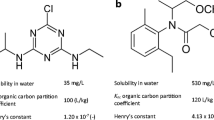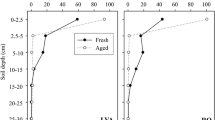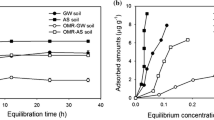Abstract
The primary aim of this study was to evaluate the “clearance concept” as a tool for describing the behavior of xenobiotic movement into and through soils. As an example, degradation of 2-chloro-4-ethylamino-6-isopropylamino-s-triazine (atrazine) with the formation of metabolites 2-chloro-6-isopropylamino-s-triazine (desethylatrazine) and 2-chloro-4-ethylamino-s-triazine (desisopropylatrazine) was investigated. Atrazine was sprayed post-emergently in doses of 0.125 or 0.5 g active ingredient/m2 each on four test plots. Soil type was a sandy-loam, on which corn (Zea mays L.) was cultivated. Soil samples were taken as cores of 0.2 m depth 0, 1, 2, 4, 8, 12, 16 and 20 weeks after application of atrazine, and analyzed by HPLC. Soil concentrations of atrazine were highly correlated (r=0.993, p< 0.001) between the two applications of 0.125 g/m2 and 0.5 g/m2. Up to 50% of the atrazine was measured as metabolites during the whole vegetation period. Clearance of atrazine from soil was calculated as the total load of atrazine divided by the area under the soil atrazine concentration time curve. Soil atrazine clearance was calculated as 5.13 +/− SD 1.10 and 5.17 +/− SD 1.02 liter of soil per day for doses of 0.125 g/m2 and 0.5 g/m2, respectively (from a “soil unit” of 1 × 1 × 0.2 meter). The clearance concept might be a tool for risk assessment of xenobiotics.
Similar content being viewed by others
References
Adams, C.D.;Thurman, E.M.: Formation and transport of deethylatrazine in the soil and vadose zone. J. Environ. Qual.,20 (1991) 540–547
Bradley, S.E.: Clearance concept in renal physiology. In Renal Physiology: People and Ideas. (Ed.C.W. Gottschalk, R.W. Berliner andG.H. Giebisch, American Physiological Society, Bethesda MD). Waverly Press, Williams and Williams Co., Baltimore MD. (1987) 63–100
Buser, H.R.: Atrazine and other s-triazine herbicides in lakes and in rain in Switzerland. Environ. Sci. Technol.24(7) (1990) 1049–1058
Del Re, A.A.M.;Capri, E.;Bergamaschi, E.;Trevisan, M.: Herbicides movement and persistence in soil: Comparison between experimental data and predictions of a mathematical model. Pesticicdes in soil and water BCPC MONO47 (1991) 213–219
Geller, A.: Studies on the degradation of atrazine by bacterial communities enriched from various biotopes. Arch. Environ. Contam. Toxicol.9(3) (1980) 289–305
Jury, W.A.;Farmer, W.J.;Spencer, W.F.: Behavior assessment model for trace organics in soil 2. chemical classification and parameter sensitivity. J. Environ. Qual.13 (1984) 567–572
Karlaganis, G.; von Arx, R.;Ammon, H.-U.;Camenzind, R.: Highperformance liquid Chromatographic determination of atrazine, deisopropylatrazine and deethylatrazine in soils from corn fields. J. Chromatogr.549 (1991) 229–236
Karlaganis, G.;Bradley, S.E.: Soil atrazine clearance: Application of a physiologic and clinical pharmacologie approach in environmental science. Chemosphere24(11) (1992) 1645–1652
Klotz, U.: Klinische Pharmakokinetik. Gustav Fischer Verlag, Stuttgart/New York. (1984) 107–153
Kozel, R.: Erfassung organischer Spurenbelastungen, insbesondere durch Pflanzenbehandlungsmittelrückstände, in oberflächennahen Lockergesteins-Grundwässern. Dissertation, University of Neuchâtel. (1992)
Lyman, W.J.;Reehl, W.F.;Rosenblatt, D.H.: Handbook of chemical Property Estimation Methods: Environmental behaviour of organic compounds. McGraw-Hill, New York15 (1982) 15–29
Maigre, D.P.: Contribution à l’étude des biotypes resistants aux triazines: évolution flonstique en monoculture de mais (Zea mays L.) et étude de résidus dans un cas particulier. Dissertation, Swiss Federal Insitute of Technology, Zürich (1988).
Moeller, E.;McIntosh, J.F.; Van Slyke, D.D.: Studies of urea excretion. II. Relationship between urine volume and the rate of urea excretion by normal adults. J. Clin. Invest.6 (1928) 427–465
Müller, U.: Jahresbericht 1991 Kantonales Laboratorium Bern. (1992) 102–105
Patumi, M.;Marucchini, C.;Businelli, M.;Tafuri, F.: Effect of repeated atrazine treatments on its persistence in soils used only for growing maize. Agrochimica25(2) (1981) 162–167
Persoone, G.; Janssen, C.R.; Van Steertegem: Extensive and updated literature study of the toxicity and ecotoxicity of atrazine — Final report. Comission of the European Communities (1991) p.21
Pestemer, W.;Radulescu, V.;Walker, A.;Ghinea, L.: Residualwirkung von Chlortriazin-Herbiziden im Boden an drei rumänischen Standorten. I. Prognose der Persistenz von Simazin und Atrazin im Boden. Weed research24 (1984) 359–369
Ramsteiner, K.;Hörmann, W.D.;Eberle, D.O.: Bestimmung von Triazinmetaboliten-Rückständen im Boden. Mededelingen van de Fakulteit Landbouwwittenschappen36 (3/4) (1971) 1119–1131
Rowland, M.;Benet, L.Z.;Graham, G.G.: Clearance concepts in pharma-cokinetics. J. Pharmacokin. and Biopharm1 (1973) 123–136
Schiavon, M.: Studies of the leaching of atrazine, of its chlorinated derivatives, and of hydroxyatrazine from soil using 14C ring-labeled compounds under outdoor conditions. Ecotoxicol. Environ. Safety15(1) (1988a) 46–54
Schiavon, M.: Studies of the movement and the formation of bound residues of atrazine, of its chlorinated derivatives, and of hydroxyatrazine in soil using 14C ring-labeled compounds under outdoor conditions. Ecotoxicol. Environ. Safety15(1) (1988b) 55–61
Singh, G.;Spencer, W.F.;Cliath, M.M.; van Genuchten, M.Th.: Dissipation of s-triazines and thiocarbamates from soil as related to soil moisture content. Env. Pollution66 (1990) 253–262
Sirons, G.J.;Frank, R.;Sawyer, T.: Residues of atrazine, cyanazine, and their phytotoxic metabolites in a clay loam soil. J. Agr. Food Chem.21(6) (1973) 1016–1020
Smith, H.W.;Goldring, W.;Chasis, H.: The measurement of the tubular excetory mass, effective blood flow, and filtration rate in the normal kidney. J. Clin. Invest.17 (1938) 263–278
Swann, R.L.;Laskowski, D.A.;McCall, P.J.; Vander Kuy, K.;Dishburger, H.J.: A rapid method for the estimation of the environmental parameters octanol/water partition coefficient, soil sorption constant, water to air ratio, and water solubility. Res. Rev.85 (1983) 16–28
Walker, A.;Barnes, A.: Simulation of herbicide persistence in soil; a revised computer model. Pestic. Sci.12 (1981) 123–132
Walker, A.;Zimdahl, R.L.: Simulation of the persistence of atrazine, linuron and metolachlor in soil at different sites in the USA. Weed Research21 (1981) 255–265
Winkelmann, D.A.;Klaine, S.J.: Atrazine metabolite behaviour in soilcore microcosms; formation, disappearance, and bound residues. ACS Symp. Ser.459 (1991) 75–92
Author information
Authors and Affiliations
Rights and permissions
About this article
Cite this article
Hari, T., von Arx, R., Ammon, H.U. et al. Clearance of atrazine in soil describing xenobiotic behavior. Environ. Sci. & Pollut. Res. 3, 32–38 (1996). https://doi.org/10.1007/BF02986811
Received:
Accepted:
Issue Date:
DOI: https://doi.org/10.1007/BF02986811




